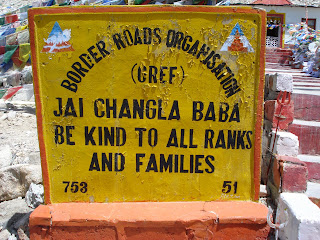
The monastery looked nice and again we wandered around blankly trying to make sense of the deities.
The sun got a little higher as we moved on to Alchi and reached just before lunchtime. Alchi’s monastery turned out to be a pleasant surprise. It is an excellent example of a Buddhist temple built under the Kashmiri influence. The people in various murals did not have slanting eyes but the full, popping-out Indian version. There was a small picture of the king and queen who had funded the construction. There was a lovely statue of the four Buddha Dhyanis, each facing a different direction and painted in a different colour. The murals, statues, architecture, all of them seemed considerably richer than that of any other monastery. We sat and just breathed in the air for a while.
Lunch involved eating well and watching a gang of five young, Punjabi couples who sat around a table and had nothing to say to each other. Eventually one of them played music from his mobile, filling up the silence at their table and breaking the harmony in others. We quickly got out of our stupor and pushed off to our next destination.
Magnetic Hill is a bit of a science project. For some strange reason, cars on that road can move uphill when the ignition is off. We reached the spot and watched with wonder as Stanzin switched off the engine, put the car on neutral and the car began to move uphill. There is a scientific explanation attached to this but I must say the whole uphill movement seemed pretty convincing.
The spots for the day had been done quite early and there was enough time to check out a local museum called Hall of Fame. It had been funded by the airforce and contained a lot of information on the Kargill war and the Siachen glacier. In addition, it also had a general overview of local culture, fauna and flora. Despite being a time filler for us, it turned out to be a very worthwhile visit. Especially for people like me who had clearly skipped out on a lot of history. Catching up on how India began to fight the world’s highest battle at Siachen was in equal parts fascinating and depressing.
Our last day had zoomed by and in no time we were having one last Ladakh meal at Pumpernickel. The next morning we would all be off to our respective homes. Most of which involved landing bang in the midst of civilisation, noise and pollution.
And would be left with memories of random things. Like the day Sandeep emerged into the bright sunlight from his tent in Tso Moriri to walk towards the washrooms. And announced to the world ‘Gosh, I never thought I would go to the loo someday with my sun glasses’
As usual, we had laughed ourselves silly. And would probably continue to do so for a few days to come.






